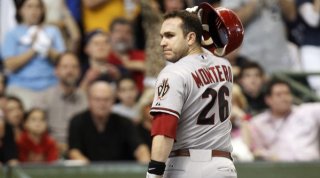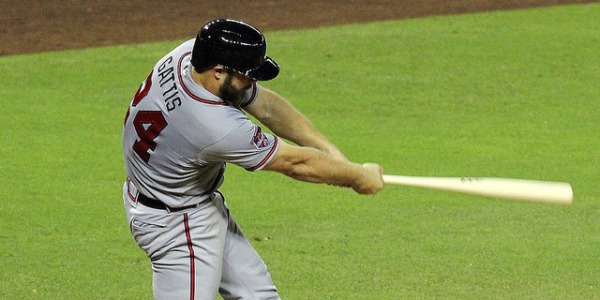2013 Fantasy Baseball, Total Runs Series: Catchers

 I ran a series like this a couple of months ago. It’s time to take another look at this key statistic and what it means for your fantasy team. Last time, we took a look at how your fantasy draft went in comparison with performance. With the season winding down for most folks, a fresh look at what has been can help now and into the future.
I ran a series like this a couple of months ago. It’s time to take another look at this key statistic and what it means for your fantasy team. Last time, we took a look at how your fantasy draft went in comparison with performance. With the season winding down for most folks, a fresh look at what has been can help now and into the future.
I spent the better part of a July in a writing seminar. I one of the lucky souls that gets to teach the next generation how to write. Those that read my columns regularly are probably shuttering at the news that I teach writing. Well, hopefully I won’t mess that up too badly. One of the lessons we learned was the importance of teaching attribution. In order to model that lesson, I will attribute the night away before releasing the catching numbers.
If you read my early work at this site, you probably have heard the term total run index before. Total run index is a metric I created out of a combination of other more common metrics that most hard-core baseball fans are familiar with. Compiling TRI is a cumbersome process that takes place during the offseason. During the season I like to look for reasonable alternatives and I found one in Bill James‘ total runs.
Total runs takes a players runs created, baserunning runs, and Dewan Fielding runs and combines it into one metric. James also assigns each position a run value and combines it all to sort of handicap the MVP race. For our purposes, I have removed the fielding runs and position multiplier and compiled a more simple number for us to look at.
What we will do in this series is simply look at where the players ranked before the season according to Yahoo at their position. That by itself deserves some explanation as some players are eligible at more than one position. I used the players at their primary positions from the 2012 season, so the positional ranking will not look exactly as it does on Yahoo. However, it gives us a pretty good benchmark of how the player was rated coming into the season.
The obvious implication is that some players will be better than their preseason ranking and some will be worse. The idea is to identify players that are undervalued and may be available. In order to do that, we will look at the top twenty players at each position according to total runs. Undoubtedly, at least a few players at each position may still be available. More importantly though, we will eventually find patterns that will help us determine why players were underrated or overrated.
Occasionally, players just have bad seasons. For instance, Miguel Montero made the top twenty, but was expected to be in the top ten. There wasn’t much in his past to help us predict a down season. These things happen. Yet, there are other players who should have been picked higher, but weren’t for various reasons. If we get a handle on these things now then we come into future fantasy drafts more prepared. We’ll take a look at the table and see if we can identify any prime candidates.
|
PRE |
RC |
BR |
TOT |
|
| Joe Mauer |
2 |
72 |
-1 |
71 |
| Buster Posey |
1 |
66 |
-5 |
61 |
| Carlos Santana |
3 |
61 |
0 |
61 |
| Yadier Molina |
5 |
61 |
-4 |
57 |
| Mike Napoli |
9 |
54 |
1 |
55 |
| Jason Castro |
23 |
52 |
-1 |
51 |
| Jonathan Lucroy |
14 |
51 |
-4 |
47 |
| Victor Martinez |
4 |
49 |
-4 |
45 |
| Wilin Rosario |
7 |
46 |
-2 |
44 |
| Matt Wieters |
6 |
44 |
-1 |
43 |
| Jarrod Saltalamacchia |
18 |
43 |
-1 |
42 |
| Russell Martin |
19 |
42 |
0 |
42 |
| Brian McCann |
11 |
41 |
-1 |
40 |
| Salvador Perez |
10 |
36 |
0 |
36 |
| A.J. Pierzynski |
13 |
37 |
-2 |
35 |
| A.J. Ellis |
25 |
34 |
0 |
34 |
| John Buck |
24 |
33 |
1 |
34 |
| Miguel Montero |
8 |
34 |
-1 |
33 |
| J.P. Arencibia |
17 |
33 |
-2 |
31 |
| Welington Castillo |
20 |
32 |
-1 |
31 |
If we take a look at the preseason top ten we notice a couple of interesting names in addition to Miguel Montero. Matt Wieters barely sneaks into the top ten in spite of being ranked sixth before the season. We should have seen this coming as he wasn’t a top ten catcher last season according to total runs. If you followed the fielding series that finished this week you’ll know that Wieters is highly regarded defensively and that defensive reputation probably enhanced his fantasy value.
Jason Castro exists on the other end of the spectrum. His case is a bit more interesting because he under-performs in two of the five major fantasy categories through no fault of his own. Houston’s anemic offense limits his run scoring and RBI territories. Yet, he is on pace to hit nearly 20 home runs and more than 40 doubles. Add to that some solid on base skills and you have the makings of a fantasy regular. He began showing that in the second half last season, so we should have seen this coming,
Similarly, A.J. Ellis was lowest rated catcher in the top twenty. Just like Castro, he has very good on base skills and those skills make him better than the traditional fantasy numbers show him to be. With that offense, it should also enhance his ability to score runs. Moreover, he might be a guy available in many of your fantasy leagues.





